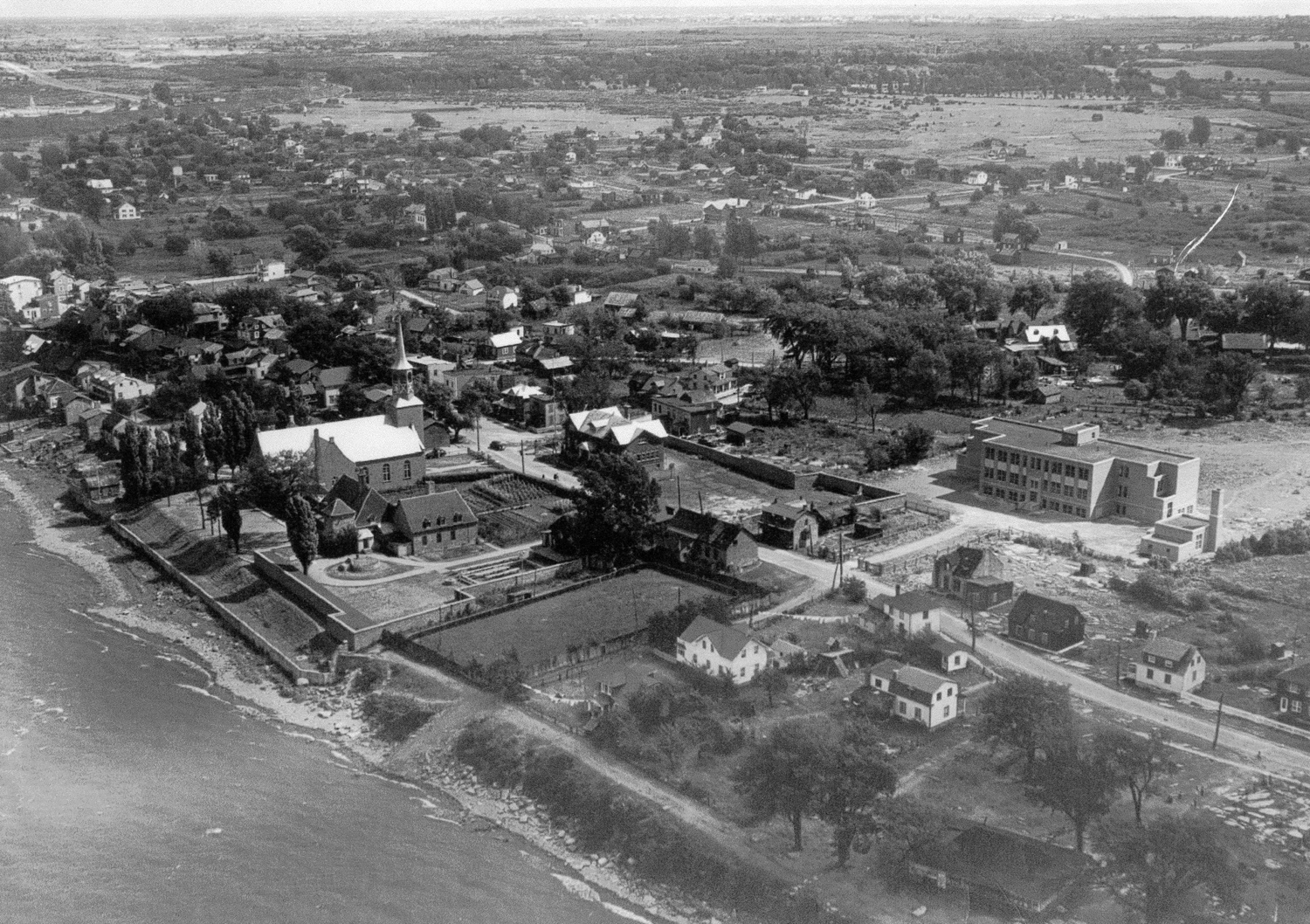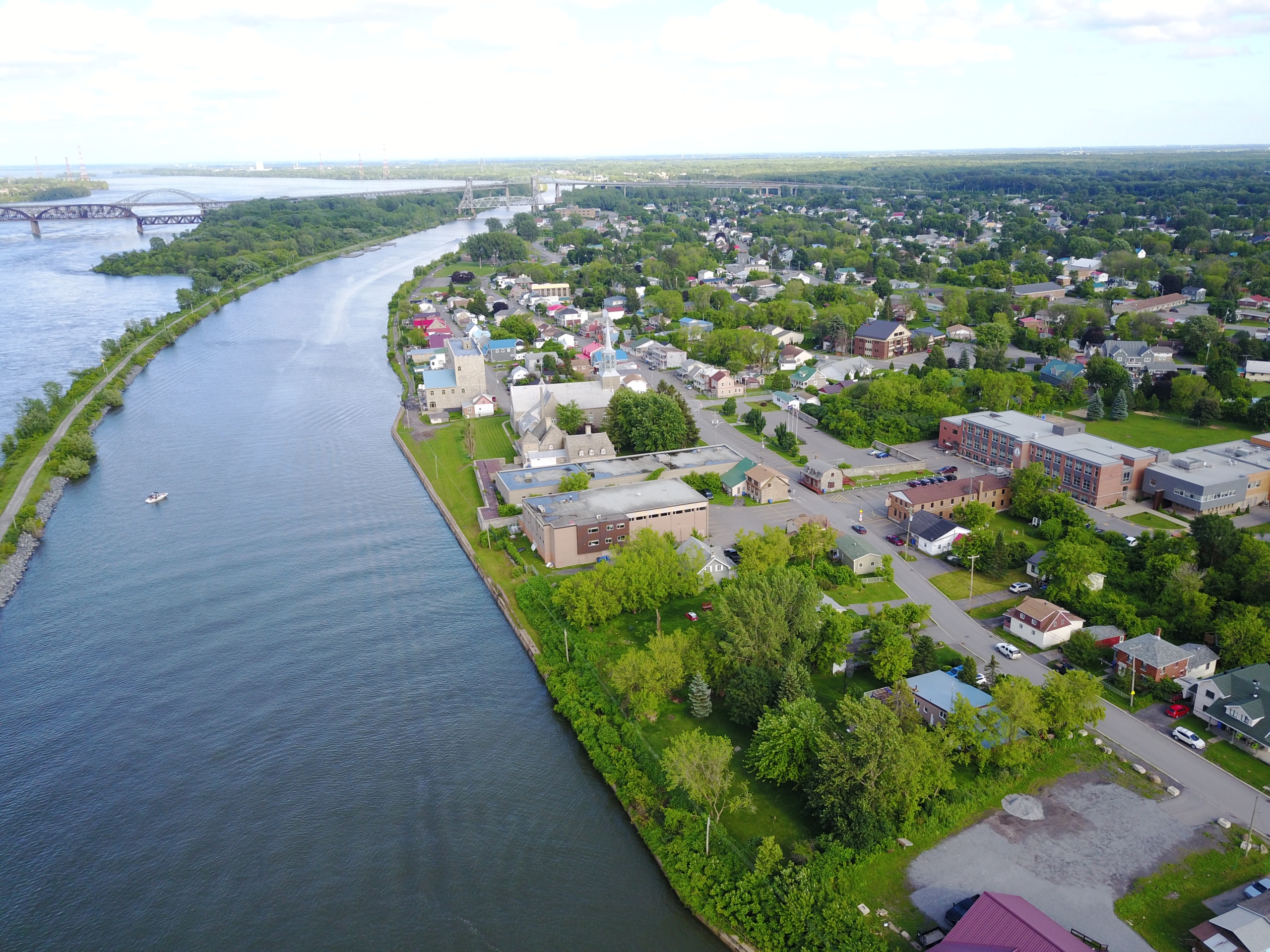The Kanien’kehá:ka (Mohawk)

Aerial view of Kahnawà:ke in 1949. (Photo : Roy Montour)
This text was published by the Kahnawà:ke Tourism Office as part of the Visit your neighbouring community insert, published in our paper version of the July 20th edition.
The Kanien’kehá:ka (sometimes referred to as Mohawk) are considered to be the Keepers of the Eastern Door, sharing with the Seneca the responsibility for guarding the doorways of the symbolic longhouse that represents the Rotinonhsión:ni Confederacy.
Because of their geographic location in the east, the Kanien’kehá:ka were the first of the Rotinonhsión:ni nations to encounter Europeans. The Kanien’kehá:ka had established trade contacts with the Dutch in the early seventeenth century, who referred to the Kanien’kehá:ka as the Maquas or Mohawk. Soon after this, the Dutch and the Kanien’kehá:ka formalized their relationship with Tékeni Teiohá:te – The Two Row Wampum. The Two Row Wampum became the template for all Rotinonhsión:ni relationships with European settlers, based upon the tenets of coexistence and non-interference.
Kahnawa:ke (By the Rapids)
Traditionally the Kanien’kehá:ka were swidden (slash and burn) agriculturists; moving villages from time to time to prevent to prevent soil erosion and exhaustion. In some instances, Kanien’kehá:ka settlements were relocated in order give the whole nation a better vantage point in dealing with other native nations or Europeans. Often migrations were accompanied by military alliance, and in some cases by religious conversion. In 1667, a group of Oneida and Kanien’kehá:ka moved from their homes around Albany and settled at La Prairie, a French Jesuit retreat south of Montreal. Some of these Kanien’kehá:ka and Oneida had been converted to Catholicism by Jesuit missionaries in the southern cantons. Their numbers swelled during the next nine years, and by 1676 there were more inhabitants at Kenhtà:ke (On the Prairie) than the land could support, and a migration was planned to Kahnawà:ke, farther up the St. Lawrence River.
Kenhtà:ke had been a Jesuit residence that received Kanien’kehá:ka from the south. The newly established settlement of Kahnawà:ke, was from its beginning an Iroquois community. The Kanien’kehá:ka called their new settlement Kahnawà:ke after the name of another settlement two hundred miles south, on the Mohawk River. To the French, this new settlement was referred to as Sault St. Louis, to the English it was referred to as Caughnawaga.
Kahnawà:ke after the name of another settlement two hundred miles south, on the Mohawk River. To the French, this new settlement was referred to as Sault St. Louis, to the English it was referred to as Caughnawaga.
Kahnawa:ke Today
Kahnawà:ke today. (Photo : Rahnienhawe McComber)
“Kahnawà:ke” best translates to “By the Rapids” and derives from when our ancestral community was located downriver, closer to the rapids. As residents, we refer to ourselves as Kahnawa’kehró:non.
Kahnawà:ke is currently situated on 11,888 acres.
While some lands have been returned to the people of Kahnawà:ke, there is still an ongoing land grievance known as the Seigneury of Sault-St-Louis, which entitles Kahnawà:ke to land that is over three times its current size.
In truth, the ancestral territory of the Kanien’kehá:ka is actually much larger and stretches into the United States.
The Number of people living on-reserve is approximately 8,000, and the number of people living off-reserve is roughly 3,000.
Kahnawà:ke is home to Olympians, NHL players, NLL players, artists and Cartoonists, Nascar Drivers, Actors and actresses, filmmakers, singers, doctors, nurses, teachers, entrepreneurs, managers, CEOs, lawyers, judges, ironworkers, and veterans. All of whom have helped raise Kahnawà:ke to a high level of recognition on an international scale.”
To learn more, we invite you to contact Kahnawa:ke Tourism at kahnawaketourism.com
